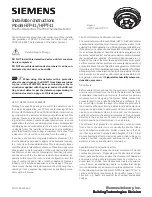
STEP 3
Once at the desired module/loop or device,
select the
Control
option by pressing the
button with the lit green triangle pointing to
the Control Tab. The screen displays several
options which can be selected using the Touch
Screen.
STEP 4
If not already logged in, the used is prompted
for a password. Enter the password as
configured in the Zeus tool using the touch
screen. Once the password is entered
correctly, allow the panel to validate it by
pressing the button with the lit green triangle
pointing to the Done tab.
STEP 5
“Touch” the box labelled
Disable ASD
, or
Enable ASD
if that is the desired operation.
STEP 6
The PMI/PMI-2 presents a confirmation screen
listing the operation requested and its scope.
Complete the operation by pressing the button
with the lit green triangle pointing to the
Execute tab.
DETECTOR CLEANING AND MAINTENANCE
Fire-Finder-XLS automatically indicates the trouble message
Input Device Requires Service
for any detector whose smoke
sensitivity increases to the level where normally low levels
of smoke generate an alarm. (Refer to the FireFinder-XLS
System Manual, P/N 315-033744 for further explanation.) FS-
250 panels indicate
Maint Alert
for any detector whose smoke
chamber changes to the level where the set sensitivity can-
not be maintained. In such circumstances, the detector may
require cleaning as a result of dust accumulation; follow the
CLEANING PROCEDURE
steps described below.
The recommended requirement for detector maintenance
consists of the annual cleaning of dust and debris from the
detector head. Cleaning program intervals should be geared
to the individual detector environment.
If the fire alarm control panel is connected to
a Fire Department, etc., or activates an external system
(fire extinguishing, etc.), disarm the appropriate outputs
before servicing to prevent activation. Be sure to reset
and rearm the system at completion of servicing. Notify
facility personnel that the system is being serviced so
that any alarm soundings can be ignored during the pe-
riod of service.
CLEANING PROCEDURE*
(See Figure 3)
1.
Notify the proper personnel that the fire alarm system
is being serviced.
P/N 315-033290-11
Siemens Industry, Inc.
Building Technologies Division
Florham Park, NJ
Siemens Canada Limited
2 Kenview Boulevard
Brampton, Ontario
L6T 5E4 Canada
2.
Remove the detector to be cleaned from its base. (See
To Remove Detector Head
on page 3.)
3.
Using a small blade screwdriver, remove the cover from
the rest of the detector by releasing the 2 cover tabs
located on the outside of the cover. Separate the foam
screen from the cover.
4.
Remove the labyrinth from the sensing chamber by
squeezing the labyrinth sides along the release axis and
pulling out. Carefully remove the labyrinth/thermal
holder assembly being sure not to damage or discon-
nect the thermal wires.
5.
Clean dust from the detector cover, foam screen, sens-
ing chamber and labyrinth using a brush, or by blowing
with compressed air.
Do not use a compressed air supply that may
contain an oil residue.
Do not remove or loosen the two screws on
the rear of the detector, or calibration data
will be lost.
The insect screen and labyrinth may be re-
placed with new parts, rather than be cleaned. Contact
Siemens Industry, Inc. Product Service to order Detector
Maintenance Kit, Model DMK-11. Do not disconnect the
thermal wires from the detector.
6.
Reassemble the detector by reversing the steps used
for disassembly, and reinstall in its base.
7.
Test the detector. (See Detector Testing section of this
instruction.)
8.
When all service has been completed, notify personnel
(See Step 1) that system service has been completed.
No field repair of the detectors should be at-
tempted. The detectors are factory repairable
only.
*
Model HFPT-11 is not field cleanable.
COVER
LABYRINTH
LOCKING
SCREW
(OPTIONAL)
COVER TAB
SENSING
CHAMBER
RELEASE
AXIS
RELEASE
AXIS
(MATCHES AXIS
OF REAR SCREWS)
THERMAL
FOAM
SCREEN
Figure 3
Disassembling of Photochamber
Siemens Ltd.
R. S. No 16/8,
Kurumbapet Village 605009
Pondicherry, India




